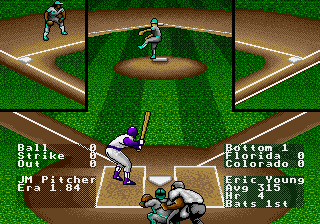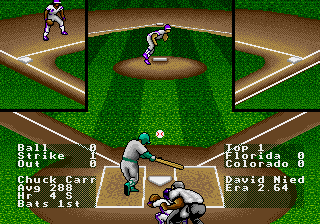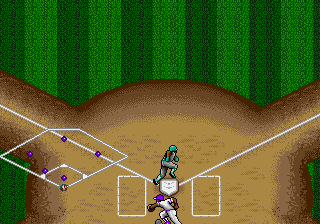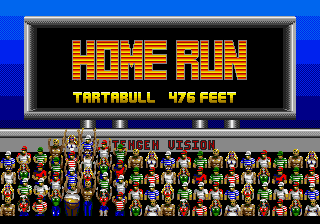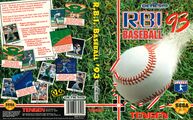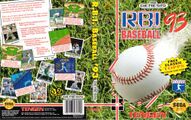R.B.I. Baseball '93
From Sega Retro
| R.B.I. Baseball '93 | ||||||||||
|---|---|---|---|---|---|---|---|---|---|---|
| System(s): Sega Mega Drive | ||||||||||
| Publisher: Tengen | ||||||||||
| Developer: Tengen | ||||||||||
| Licensor: Atari Games, Major League Baseball Players Association | ||||||||||
| Sound driver: Lisa's Sound Driver[1] | ||||||||||
| Genre: Sports (baseball) | ||||||||||
| Number of players: 1-2 | ||||||||||
|
R.B.I. Baseball '93 is the sequel to R.B.I. Baseball 4. It was released exclusively for the Sega Mega Drive in North America.
Contents
Gameplay
The game is a baseball game featuring the 26 teams and stadiums of the 1992 MLB season, plus the two expansion teams that would debut in the 1993 season (the Colorado Rockies and the Florida Marlins, which have partial rosters, with some players identified only by position). It has a Major League Baseball Players Association license, so it uses real player names, but it does not have a Major League Baseball license, so teams are identified only by locale and not by name. Gameplay is largely carried over from the previous entry without modification (including all of the Game Breakers scenarios), but it adds a new mode (Defense Practice), the ability to customize teams, and a setting for auto-fielding.
Modes
The game has the following modes:
- Play Ball: A nine-inning exhibition game between any two teams from either league (which can be the same team) or a series. The selectable series are Best of Seven (play any team in a best of seven playoff series), Play Division (play against every team in the 1992 American League, 1992 National League, American division winners, or National division winners), or Play All Teams (play against every team in the game). Series games use a password system for continuing.
- Home Run Derby: Players choose a team, a batter, and a pitch speed (60, 70, 80, 90, or 100). Each player gets 20 pitches and tries to hit as many home runs as possible. In two-player games, the stadium used belongs to player one's team. Awards are given for 3 (bronze), 5 (silver), 8 (gold), or 11 or more (grand prize) runs.
- Game Breakers: Players choose a team. Rather than starting a new game, players choose from a list of 17 situations, such as starting the eight inning down nine points, starting the ninth inning with neither team having any points, or being in the bottom of the eighth inning ahead one point but with the opposing team having bases loaded and no outs. After choosing a situation, players choose a relief pitcher and finish the game with the selected premise. A password is given after each completed game.
- Create Teams: Players can create custom teams with any players, which can be used in any of the other modes.
- Stadium Tour: An overhead view of any of the 30 ballparks in the game (one for every team, plus an American League and a National League stadium).
- View Roster: View all of the team rosters and statistics for any player.
- Defense Practice: Practice playing defense in 20 different infield and outfield defensive situations. A computer-controlled batter hits a ball off a tee, and the player controls the fielders.
Games can be played as Human vs. Comp (single-player, where the player is the visiting team and bats first), Comp vs. Human (single-player, where the player is the home team and bats last), Human vs. Human (two-player game, where player two as the home team), or Comp vs. Comp (two computer-controlled teams play each other, which can be overridden by either control pad to take over play or make substitutions). Before each game, players choose any team and set the batting line-up and choose starting and relief pitchers. A pitcher can only start every other game in a series.
Players can choose from three difficulty levels for computer-controlled opponents (Easy, Medium, and Hard) and set the defense mode (computer-assisted for partial assistance or fully automated or manual fielding).
Teams
Current
The game includes all 28 teams from the 1992 MLB season, with their stadiums.
| League | Division | Team | Based on |
|---|---|---|---|
| American | West | California | California Angels |
| Chicago | Chicago White Sox | ||
| Kansas City | Kansas City Royals | ||
| Minnesota | Minnesota Twins | ||
| Oakland | Oakland Athletics | ||
| Seattle | Seattle Mariners | ||
| Texas | Texas Rangers | ||
| East | Baltimore | Baltimore Orioles | |
| Boston | Boston Red Sox | ||
| Cleveland | Cleveland Indians | ||
| Detroit | Detroit Tigers | ||
| Milwaukee | Milwaukee Brewers | ||
| New York | New York Yankees | ||
| Toronto | Toronto Blue Jays | ||
| National | West | Atlanta | Atlanta Braves |
| Cincinnati | Cincinnati Reds | ||
| Colorado | Colorado Rockies | ||
| Houston | Houston Astros | ||
| Los Angeles | Los Angeles Dodgers | ||
| San Diego | San Diego Padres | ||
| San Francisco | San Francisco Giants | ||
| East | Chicago | Chicago Cubs | |
| Florida | Florida Marlins | ||
| Montreal | Montreal Expos | ||
| New York | New York Mets | ||
| Philadelphia | Philadelphia Phillies | ||
| Pittsburgh | Pittsburgh Pirates | ||
| St. Louis | St. Louis Cardinals |
Previous
In addition, the game includes historical rosters of every division-winning team going back to 1984.
| League | Year | West | East | ||
|---|---|---|---|---|---|
| Team | Based on | Team | Based on | ||
| American | 1991 | Minnesota | Minnesota Twins | Toronto | Toronto Blue Jays |
| 1990 | Oakland | Oakland Athletics | Boston | Boston Red Sox | |
| 1989 | Oakland | Oakland Athletics | Toronto | Toronto Blue Jays | |
| 1988 | Oakland | Oakland Athletics | Boston | Boston Red Sox | |
| 1987 | Minnesota | Minnesota Twins | Detroit | Detroit Tigers | |
| 1986 | California | California Angels | Boston | Boston Red Sox | |
| 1985 | Kansas City | Kansas City Royals | Toronto | Toronto Blue Jays | |
| 1984 | Kansas City | Kansas City Royals | Detroit | Detroit Tigers | |
| National | 1991 | Atlanta | Atlanta Braves | Pittsburgh | Pittsburgh Pirates |
| 1990 | Cincinnati | Cincinnati Reds | Pittsburgh | Pittsburgh Pirates | |
| 1989 | San Francisco | San Francisco Giants | Chicago | Chicago Cubs | |
| 1988 | Los Angeles | Los Angeles Dodgers | New York | New York Mets | |
| 1987 | San Francisco | San Francisco Giants | St. Louis | St. Louis Cardinals | |
| 1986 | Houston | Houston Astros | New York | New York Mets | |
| 1985 | Los Angeles | Los Angeles Dodgers | St. Louis | St. Louis Cardinals | |
| 1984 | San Diego | San Diego Padres | Chicago | Chicago Cubs | |
All-Star
Finally, the game includes All-Star teams for each league going back to 1989.
| League | Team |
|---|---|
| American | 1992 American League All-Stars |
| 1991 American League All-Stars | |
| 1990 American League All-Stars | |
| 1989 American League All-Stars | |
| National | 1992 National League All-Stars |
| 1991 National League All-Stars | |
| 1990 National League All-Stars | |
| 1989 National League All-Stars |
Production credits
- : Mike Alexander, Jose Erazo, Doug Gray, Earl Vickers, Doug Coward, Mike Klug Bill Hindorff, Brad Fuller, John Paul, Don Diekneite, Greg Williams, Rob Boone, John Arvay Jr.
Magazine articles
- Main article: R.B.I. Baseball '93/Magazine articles.
Promotional material
also published in:
- GamePro (US) #48: "July 1993" (1993-xx-xx)[5]
- VideoGames & Computer Entertainment (US) #55: "August 1993" (1993-0x-xx)[6]
- GamePro (US) #51: "October 1993" (1993-xx-xx)[7]
- Electronic Gaming Monthly (US) #52: "November 1993" (1993-xx-xx)[8]
Physical scans
| Sega Retro Average | |||||||||||||||||||||||||||||||||||||||||||||||||
|---|---|---|---|---|---|---|---|---|---|---|---|---|---|---|---|---|---|---|---|---|---|---|---|---|---|---|---|---|---|---|---|---|---|---|---|---|---|---|---|---|---|---|---|---|---|---|---|---|---|
|
| 72 | |
|---|---|
| Based on 9 reviews | |
Technical information
- Main article: R.B.I. Baseball '93/Technical information.
References
- ↑ http://vgmpf.com/Wiki/index.php?title=LSD_(GEN_Driver)
- ↑ File:EGM US SportsDirectory 1993.pdf, page 7
- ↑ 3.0 3.1 GamePro, "June 1993" (US; 1993-xx-xx), page 127
- ↑ The Cutting Room Floor: R.B.I. Baseball %2793
- ↑ GamePro, "July 1993" (US; 1993-xx-xx), page 55
- ↑ VideoGames & Computer Entertainment, "August 1993" (US; 1993-0x-xx), page 3
- ↑ GamePro, "October 1993" (US; 1993-xx-xx), page 71
- ↑ Electronic Gaming Monthly, "November 1993" (US; 1993-xx-xx), page 77
- ↑ 1700 igr dlya Sega, "" (RU; 2001-xx-xx), page 185
- ↑ Electronic Gaming Monthly, "June 1993" (US; 1993-xx-xx), page 30
- ↑ Sega Mega Drive Advanced Gaming, "August 1993" (UK; 1993-06-24), page 29
- ↑ Mega Fun, "07/93" (DE; 1993-06-23), page 75
- ↑ Mean Machines Sega, "August 1993" (UK; 1993-06-30), page 60
- ↑ Sega Pro, "August 1993" (UK; 1993-07-08), page 68
- ↑ Sega Zone, "September 1993" (UK; 1993-08-xx), page 48
- ↑ Tricks 16 bit, "Tricks Sega Gold 800 igr" (RU; 1998-03-20), page 207
| R.B.I. Baseball '93 | |
|---|---|
|
Main page | Hidden content | Magazine articles | Reception | Region coding | Technical information | |
| R.B.I. Baseball games for Sega systems | |
|---|---|
| R.B.I. Baseball 3 (1991) | R.B.I. Baseball 4 (1992) | R.B.I. Baseball '93 (1993) | R.B.I. Baseball '94 (1994) | R.B.I. Baseball '95 (unreleased) | RBI Baseball '95 (1995) | |

